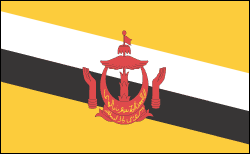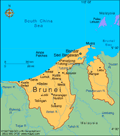Brunei | Facts & Information

- Brunei Profile
- History
Infoplease has everything you need to know about Brunei. Check out our country profile, full of essential information about Brunei's geography, history, government, economy, population, culture, religion and languages. If that's not enough, click over to our collection of world maps and flags.
Facts & Figures
-
Brunei Darussalam
Sultan: Haji Hassanal Bolkiah (1967)
Land area: 2,035 sq mi (5,265 sq km); total area: 2,228 sq mi (5,765 sq km)
Population (2020 est.): 478,054 (growth rate: 1.45%); birth rate: 16.14/1000; infant mortality rate: 10.52/1000; life expectancy: 78.38; density per sq km: 72 (2012)
Capital and largest city (2011 est.): Bandar Seri Begawan, 241,000
Other large cities (2011): Kuala Belait 27,800, Seria 23,400
Monetary unit: Brunei dollar
National Name: Negara Brunei Darussalam
Languages: Malay (official), English, Chinese
Ethnicity/race: Malay 65.8%, Chinese 10.2%, other 24% (2020 est.)
National Holiday: National Day, February 23
Religions: Muslim (official) 80.9%, Christian 7.1%, Buddhist 7.1%, other (includes indigenous beliefs) 5% (2016 est.)
Literacy rate: 97.2% (2018 est.)
Economic summary: GDP/PPP (2020 est.): $27.23 billion; per capita $62,200. Real growth rate: 1.3%. Inflation: -0.2%. Unemployment: 6.9% (2017). Arable land: 0.8%. Agriculture: rice, vegetables, fruits; chickens, water buffalo, eggs. Labor force: 203,600; note: includes foreign workers and military personnel; temporary residents make up about 40% of labor force; agriculture 4.2%, industry 62.8%, services 33% (2008 est.). Industries: petroleum, petroleum refining, liquefied natural gas, construction. Natural resources: petroleum, natural gas, timber. Exports: $7.83 billion (2019 est.): crude oil, natural gas, refined products. Major trading partners (exports): Japan 34%, Australia 12%, Singapore 10%, India 8%, Malaysia 8%, Thailand 7%, China 6%, South Korea 5% (2019). Imports: $6.81 billion (2019 est.): machinery and transport equipment, manufactured goods, food, chemicals. Major trading partners (imports): Singapore 18%, China 14%, Malaysia 12%, Nigeria 5%, United Arab Emirates 5%, United States 5% (2019).
Communications: Telephones: main lines in use: 103,885 (2020); mobile cellular: 526,589 (2020). Broadcast Media: state-controlled Radio Television Brunei (RTB) operates 5 channels; 3 Malaysian TV stations are available; foreign TV broadcasts are available via satellite systems; RTB operates 5 radio networks and broadcasts on multiple frequencies; British Forces Broadcast Service (BFBS) provides radio broadcasts on 2 FM stations; some radio broadcast stations from Malaysia are available via repeaters (2022). Internet hosts: 49,403 (2011). Internet users: 415,609 (2020).
Transportation: Highways: total: 2,976 km (2014). Waterways: 209 km; navigable by craft drawing less than 1.2 m (2012). Ports and harbors: Lumut, Muara, Seria. Airports: 1 (2021 est.).
International disputes: in 2003 Brunei and Malaysia ceased gas and oil exploration in their disputed offshore and deepwater seabeds and negotiations have stalemated prompting consideration of international legal adjudication; Malaysia's land boundary with Brunei around Limbang is in dispute; Brunei established an exclusive economic fishing zone encompassing Louisa Reef in southern Spratly Islands in 1984 but makes no public territorial claim to the offshore reefs; the 2002 "Declaration on the Conduct of Parties in the South China Sea" has eased tensions in the Spratly Islands but falls short of a legally binding "code of conduct" desired by several of the disputants.









